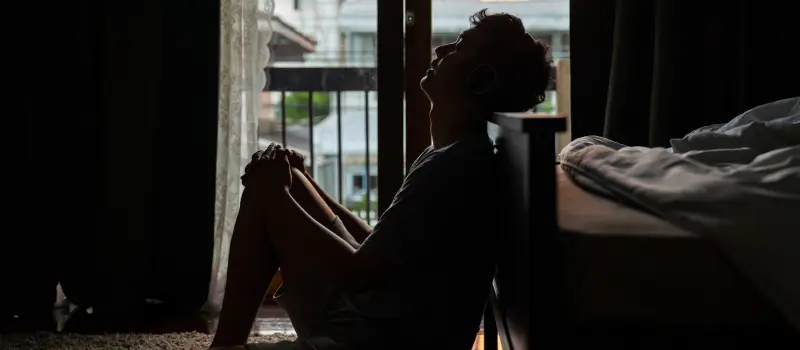
Table of Contents
What is Complex Trauma?

Written By: Ashley Laderer

Clinically Reviewed By: Dr. Don Gasparini
January 31, 2023
9 min.
Complex trauma is ongoing, repeated, and hard to escape –– potentially leaving you with long-lasting mental health consequences like C-PTSD.
Learn more about our Clinical Review Process
Table of Contents
While many people are aware of the concept of trauma and the diagnosis of post traumatic stress disorder (PTSD), the concept of complex trauma is a bit lesser-known and newer.
Complex trauma––as the name suggests––is a bit more complex than a one-off traumatic incident. It can have long-lasting negative effects on the nervous system, brain, and overall mental health.
This trauma is ongoing, repeated, and hard to escape. It can lead to a long-term mental health condition known as complex post traumatic stress disorder (C-PTSD) which has additional unique features on top of traditional PTSD symptoms.
Here’s what you need to know about complex trauma, C-PTSD, and how to heal from complex trauma.
What is complex trauma?
It is important to differentiate between acute trauma and complex trauma. Acute trauma is the result of a singular, one-off traumatic event. It can cause severe distress and potentially lead to trauma-related mental health conditions like acute stress disorder or post traumatic stress disorder.
On the other hand, when it comes to complex trauma, the main difference is that there are far more repeated and prolonged traumatic incidents that occur versus a one-off event.
Some common characteristics of complex trauma include:
- The traumatic instances were repeated or continuous over time
- The trauma was linked to personal relationships (such as within the family)
- The trauma was inescapable or very hard to escape from
- The trauma was kept under wraps so it was very secretive, or it might even be denied
Sadly, often this prolonged repeated trauma begins in childhood, in a space that is supposed to be safe (the home) with people who are supposed to be safe (the family members). Potential causes of this type of prolonged trauma during childhood and in home life include:
- Child abuse – (sexual abuse or physical abuse)
- Ongoing domestic violence in the family
However, other types of terrible circumstances can occur outside of the home and deeply affect people regardless of age, such as:
- Torture
- Organized violence
- Slavery
- Concentration camps
- Genocide
- Sex trafficking
- Being a refugee
As you can see, this is where the “difficult or impossible to escape” aspect of complex trauma comes from. For instance, a young child who is being sexually or physically abused by a parent time after time does not necessarily have the means to get out of the situation. Their parents may deny the occurrences or force the child to keep it a secret, so they are scared to ask someone else for help. Since they are a child, they don’t have the autonomy that an adult would have to safely leave and support themselves. This makes it extremely difficult for a child to get out of this situation, and they will likely be exposed to the trauma over and over again. In the case of organized violence or sexual slavery, it is quite literally impossible to escape. Regardless of the specific cause, there is no denying that repeated trauma and related extreme stress can lead to long-lasting adverse mental health effects.
Furthermore, when complex trauma occurs in childhood, there is an increased risk of trauma-induced changes to the brain that can affect overall development. This is because the brain doesn’t stop fully developing until someone is in their mid-to-late 20s. Therefore, childhood trauma can have profound effects on the developing brain.
Join the Charlie Health Library
Get mental health updates, research, insights, and resources directly to your inbox.
You can unsubscribe anytime.
What is complex PTSD (C-PTSD)?
Complex post traumatic stress disorder (C-PTSD) is a specific type of PTSD linked to complex trauma.
While in theory, complex PTSD has been around for ages, the term “complex PTSD” is relatively new. It wasn’t until 1992 that psychiatrist Dr. Judith Lewis Herman published research surrounding this type of trauma and suggested the new diagnosis of complex post traumatic stress disorder. She believed this different diagnosis was better suited to complex trauma survivors, accounting for additional unique symptoms that someone with C-PTSD may experience.
For example, outlined differences are related to a complex trauma survivor’s sense of self, relationships, and emotions. Furthermore, Dr. Herman said that complex trauma survivors are at “high risk for repeated harm, either self-inflicted or at the hands of others.”
The differences in symptoms can be attributed to the unique experiences that someone who faces complex trauma has versus someone who has faced acute trauma. Dr. Herman noted specifically the aspect of being in a “state of captivity, unable to flee, and under the control of the perpetrator” is a distinctive feature of complex trauma and C-PTSD versus PTSD.
It’s estimated that anywhere from 1% to 8% of people have complex post traumatic stress disorder.
What are the symptoms of complex PTSD?
Complex PTSD symptoms are similar to PTSD symptoms. However, on top of the traditional signs of PTSD, people with C-PTSD also have experiences that fall under the umbrella of “disturbances in self-organization,” sometimes referred to as “DSO.” The combination of the usual PTSD symptoms and the additional disturbances in self-organization can make it very difficult for complex trauma survivors to function and thrive in their day-to-day life. Their symptoms can reduce their quality of life, make it hard for them to excel at work or school, and impair their personal relationships.
General post traumatic stress disorder symptoms fall under four general categories, including:
Intrusion symptoms:
- Repeated distressing memories of the traumatic event(s)
- Recurring nightmares or dreams about the traumatic event(s)
- Flashbacks where you feel like you’re reliving the trauma now
- Feeling emotionally distressed when triggered by something that reminds you of the traumatic event(s)
- Feeling physical symptoms when triggered by something that reminds you of the traumatic event(s)
Avoidance symptoms:
- Avoiding or attempting to avoid internal reminders (like memories or thoughts) of the traumatic incident(s)
- Avoiding or attempting to avoid external reminders (such as people, places, or situations) that make you think of the traumatic incident(s)
Cognitive/mood symptoms:
- Having trouble remembering aspects of the traumatic incident(s)
- Having ongoing negative beliefs about yourself or other people
- Blaming yourself or others for the traumatic incident(s)
- Experiencing negative emotions
- Losing interest in activities you once enjoyed
- Feeling like you are detached from others
- Being unable to feel positive emotions

Arousal and reactivity symptoms:
- Anger, aggression, and irritability
- Being self-destructive or acting recklessly
- Being hypervigilant
- Being easily startled
- Having trouble concentrating
- Having trouble with sleep
Additionally, some people will experience dissociative symptoms along with PTSD. Depersonalization and derealization are two types of dissociation. Depersonalization can give you the impression that you are experiencing an out-of-body experience or that you are not connected to yourself. Derealization can make you feel like your surroundings are distorted or that your surroundings aren’t completely real.
On top of all of these general PTSD symptoms, the extra C-PTSD symptoms need to be addressed. These symptoms related to disturbances in self-organization include:
Emotional regulation difficulties
- Having trouble calming down
- Ongoing feelings of sadness
- Suicidal ideation
- Issues with anger
Relationship difficulties
- Avoiding relationships
- Isolation
- Difficulty trusting others
Negative self-concept
- Feeling like a failure
- Feeling worthless or helpless
- Feeling shame or guilt
What are the complications of complex trauma?
Complex post traumatic stress disorder is not the only potential outcome of experiencing complex trauma. The phenomenon can lead to a variety of complications that are both mental and physical.
It’s common for people with PTSD to also have co-occurring mental health conditions, such as:
A co-occurring mental health condition that is commonly linked to complex PTSD specifically is borderline personality disorder (BPD). This personality disorder has a lot of overlap in symptoms with C-PTSD.
Physical health problems may arise, as well, especially if complex trauma is due to adverse childhood experiences (ACEs) like childhood maltreatment, child abuse, or domestic violence. Research has found that ACEs are linked to adverse health outcomes such as:
- Heart disease
- Respiratory disease
- Cancer
Do you need more support with
your mental health?
Charlie Health can help.
What is the treatment for complex PTSD?
Therapy is the cornerstone of treatment of complex PTSD. The types of therapy may vary based on the individual and their symptoms and any co-occurring mental health conditions. C-PTSD may require more different types of treatment and a longer duration of treatment compared to PTSD due to its complexity.
According to the International Society of Traumatic Stress Studies (ISTSS), some experts recommend treatment with a multiphase approach, consisting of three distinct stages:
Phase 1
This phase aims to keep the trauma survivor safe and make sure they aren’t a source of danger for themselves or others. The individual and a therapist will work on reducing symptoms by learning emotional regulation skills, tools to manage stress, and skills for relationships. There should also be education surrounding complex trauma and its lasting effects. Medication might be prescribed at this point as well.
Phase 2
This phase involves facing the trauma head-on. The individual will revisit and process their trauma in a safe space with the guidance of a therapist. They will learn to explore their memories and look at them in such a way that feels safe and ultimately improves their sense of self.
Phase 3
This phase helps the individual consolidate their treatment gains and help them apply what they’ve learned in therapy in their everyday life when it comes to emotions, social life, and relationships. They will come up with a plan to continue to make progress.
While some use this three-phase approach, this is not always the case for C-PTSD treatment. No treatment modality is one-size-fits-all, and different treatment techniques or perspectives can be used based on the individual.
In general, for PTSD, types of therapy that are commonly used include:
- Cognitive behavioral therapy (CBT): Many mental health struggles, including trauma, can benefit from CBT. This type of therapy can help you become more aware of your thoughts and feelings, giving you the power to reframe negative beliefs and address unhealthy behaviors. New coping skills will help you deal with distorted thoughts, difficult emotions, and stress. Additionally, a special type of CBT called trauma-focused CBT (TF-CBT) is specifically for children and teens who are trauma survivors.
- Exposure therapy: Since trauma can make you avoid situations, places, people, or memories that remind you of the traumatic incidents, exposure therapy is a way to safely revisit these triggers with the help of a therapist. One specific type of exposure therapy is prolonged exposure (PE) which helps you gradually face these triggers. It can involve talking out loud about the events in detail, or safely exposing yourself to stimuli that might evoke a response. This helps to desensitize yourself to your triggers so they don’t cause such a strong emotional or physical reaction going forward.
- Eye movement desensitization and reprocessing (EMDR): EMDR is a unique type of therapy that utilizes your eye movements to help process traumatic and triggering emotional memories. With a trained EMDR therapist, this method can help you process trauma more quickly.
For some people, complex PTSD treatment involves psychiatric medication. Antidepressants and anti-anxiety meds are the most frequently prescribed drugs by psychiatrists for PTSD. Along with your therapy sessions, these medications can aid in managing and reducing your symptoms.
How can Charlie Health help?
If you’re a complex trauma survivor and you think you might have C-PTSD, Charlie Health may be able to help you.
Our virtual intensive outpatient program provides personalized mental health services for teens, young adults, and families dealing with a wide range of struggles, including trauma and any co-occurring conditions. All of Charlie Health’s clinicians are trauma-informed and well-equipped to help you process your trauma in a non-judgemental safe space.
While dealing with complex trauma can feel hopeless and extremely difficult at times, there is a light at the end of the tunnel. With trauma-informed care and a supportive community, you can start feeling better. Begin your healing journey with Charlie Health today.
References
https://www.isst-d.org/wp-content/uploads/2020/03/Fact-Sheet-I-Trauma-and-Complex-Trauma_-An-Overview-1.pdf
https://onlinelibrary.wiley.com/doi/abs/10.1002/jts.2490050305
https://www.myptsd.com/gallery/-pdf/1-90.pdf
https://bpded.biomedcentral.com/articles/10.1186/s40479-021-00148-8
https://www.ptsd.va.gov/professional/treat/essentials/complex_ptsd.asp
https://www.ncbi.nlm.nih.gov/pmc/articles/PMC5774393/
https://pubmed.ncbi.nlm.nih.gov/29253477/
https://www.apa.org/ptsd-guideline/treatments/prolonged-exposure





